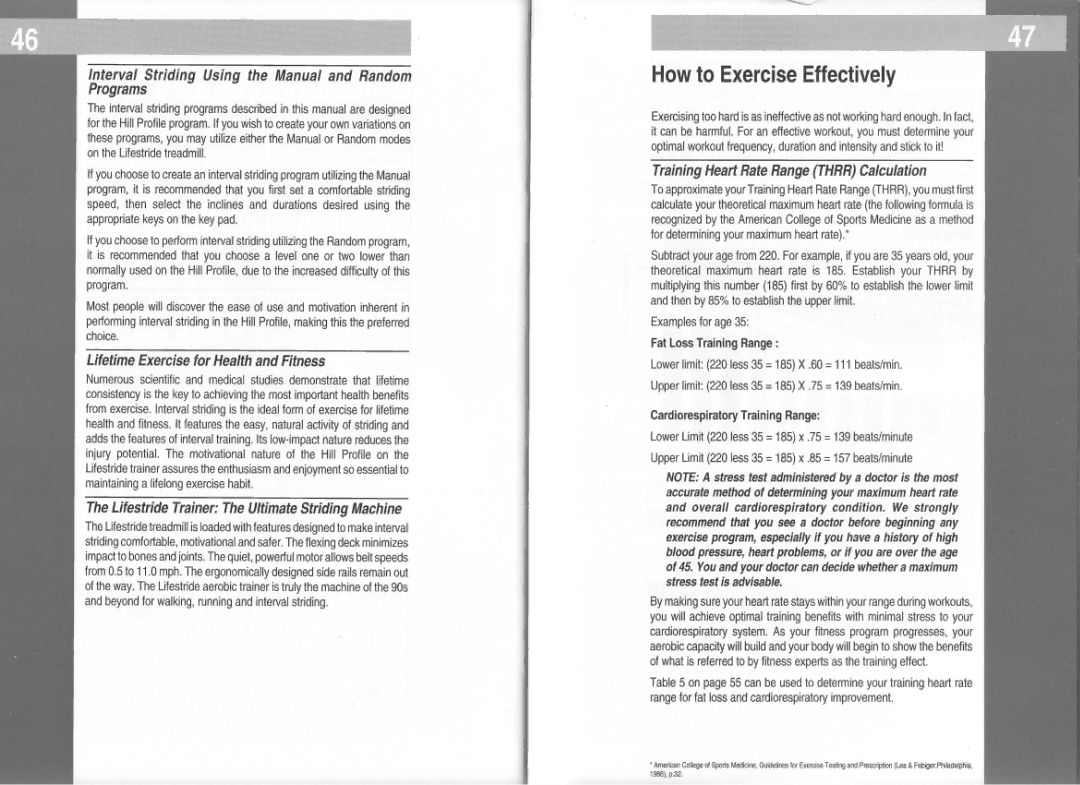
Interval Striding Using the Manual and Random Programs
The interval striding programs described in this manual are designed
for the Hill Profile program. If you wish to create your own variations on
these programs, you may utilize either the Manual or Random modes on the Lifestride treadmill.
If you choose to create an interval striding program utilizing the Manual
program, it is recommended that you first set a comfortable striding
speed, then select the inclines and durations desired using the
appropriate keys on the key pad.
If | you | choose | to perform | interval | striding |
| utilizing | the | Random | program, | |||
it | is recommended | that | you choose | a | level |
| one | or two | lower | than | |||
normally | used | on | the Hill | Profile, | due | to | the | increased | difficulty | of this | |||
program. |
|
|
|
|
|
|
|
|
|
|
|
| |
Most people will discover the ease of use and motivation inherent in
performing interval striding in the Hill Profile, making this the preferred choice.
Lifetime Exercise for Health and Fitness
Numerous scientific and medical studies demonstrate that lifetime
consistency is the key to achieving the most important health benefits
from exercise. Interval striding is the ideal form of exercise for lifetime health and fitness. It features the easy, natural activity of striding and
adds the features of interval training. Its
injury potential. The motivational nature of the Hill Profile on the
Lifestride trainer assures the enthusiasm and enjoyment so essential to
maintaining a lifelong exercise habit.
The Lifestride Trainer: The Ultimate Striding Machine
The Lifestride treadmill is loaded with features designed to make interval
striding comfortable, motivational and safer. The flexing deck minimizes impact to bones and joints. The quiet, powerful motor allows belt speeds
from 0.5 to 11.0 mph. The ergonomically designed side rails remain out of the way. The Lifestride aerobic trainer is truly the machine of the 90s and beyond for walking, running and interval striding.
[
How to Exercise Effectively
Exercising | too hard is | as | ineffective | as not | working | hard | enough. | In fact, | ||
it can | be | harmful. | For | an | effective | workout, | you | must | determine | your |
optimal | workout | frequency, | duration | and intensity | and | stick to | it! | |||
Training Heart Rate Range (THRR) Calculation
To approximate your Training Heart Rate Range (THRR), you must first
calculate your theoretical maximum heart rate (the following formula is
recognized by the American College of Sports Medicine as a method
for determining your maximum heart rate):
Subtract your age from 220. For example, if you are 35 years old, your
theoretical maximum heart rate is 185. Establish your THRR by
multiplying this number (185) first by 60% to establish the lower limit and then by 85% to establish the upper limit.
Examples for age 35:
Fat Loss Training Range:
Lower limit: (220 less 35 = 185) X .60 = 111 beats/min.
Upper limit: (220 less 35 = 185) X .75 = 139 beats/min.
Cardiorespiratory Training Range:
Lower Limit (220 less 35 = 185) x .75 = 139 beats/minute
Upper Limit (220 less 35 = 185) x .85 = 157 beats/minute
NOTE: A stress test administered by a doctor is the most
accurate method of determining your maximum heart rate
and overall cardiorespiratory condition. We strongly
recommend that you see a doctor before beginning any exercise program, especially if you have a history of high blood pressure, heart problems, or if you are over the age of 45. You and your doctor can decide whether a maximum stress test is advisable.
By making sure your heart rate stays within your range during workouts, you will achieve optimal training benefits with minimal stress to your cardiorespiratory system. As your fitness program progresses, your aerobic capacity will build and your body will begin to show the benefits of what is referred to by fitness experts as the training effect.
Table 5 on page 55 can be used to determine your training heart rate
range for fat loss and cardiorespiratory improvement.
.
American College of Sports Meoicine, Guidelines for Exercise Testing and Prescription (Lea & Febiger:Philadelphia,
1986),p.32.
